Barefoot running shoes – reviewed
Barefoot running has been one of the hottest topics of discussion among runners ever since Chris McDougall’s book Born to Run brought the subject to full light.
McDougall wrote about a theory developed by Harvard scientists that running barefoot naturally reduces your impact on the ground – by forcing you to land on your mid-foot or fore-foot rather than on your heel. This results in a more efficient running style and fewer injuries. In fact, they laid the blame for many injuries squarely at the feet of cushioned running shoes – the shoes most of us have been running in for the last 30 years.
You would imagine such an idea would have the running shoe companies issuing legal writs in a mad panic, but instead they realised that most people were not actually going to run barefoot.
For a start, many people are understandably sceptical about the benefits of removing all the cushioning and support from under your feet and then setting off on a long run.
Even among the convinced or curious, running barefoot was always going to be a bridge too far for most. The Harvard scientists studied barefoot Kenyan runners as part of their research. But in the west our feet are too soft, too used to shoes, for us to suddenly start hareing around barefoot. Also, we live in a world covered in concrete, with the risk of broken glass, nails and other sharp objects everywhere. So, instead of panicking, sports companies developed the oxymoronic concept of barefoot shoes.
Barefoot shoes, or minimalist shoes as they’re also known, were around before Born to Run was published, but they had a niche appeal. Today, however, a large proportion of running shoes on the market are barefoot shoes.
The idea behind them is to allow your foot to land on the ground in the same motion as though you were running barefoot, but at the same time to provide some protection. They come in various guises, from those designed to help you transition slowly from heel-first running to barefoot-style running, to those that just provide a thin slither of rubber under your sole, leaving your foot as free as possible.
Kate Carter and I decided to try some of the latest models out. I’ve been running in a barefoot style for about three years – I used to be a furious heel striker – while Kate is new to the whole concept. Here’s what we thought:
Nike Free 5.0+ and Nike Free 3.0+, £85
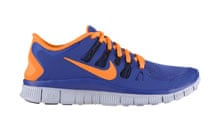
AF: The 3.0 are my current running shoes of choice. They fit like a glove, are light and bouncy and allow easy barefoot-style running. After about 15 miles they start giving me sore feet, but to be fair, Nike doesn’t recommend them for distances over 10K.
KC: Nike recommends that those new to barefoot running start off with the 5.0 model. I found these extremely comfortable and lightweight. They didn’t feel like a massive difference from my normal running shoes, but then a lot of the change is in technique as well as shoe. These also seem to me like a great all-round exercise shoe: I’d wear them to the gym. Once I’ve built up some more miles in these, I think the switch to 3.0 would come pretty seamlessly.
Vivobarefoot Evo II, £89
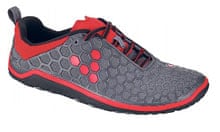
AF: I used these shoes when I first started learning to run in a barefoot-style. Because they have no cushioning at all, they really force you to run properly, which is great. Maybe I’m just lazy, or soft, but once I felt I knew what I was doing, I switched to a shoe with a tiny bit more cushioning, although I still wear these sometimes for shorter runs.
KC: I can see you would definitely need to change your running style completely to find these comfortable. I struggled with them – but then I am a heel striker so that’s unsurprising. I find the fit a bit strange – there’s a lot of room around the toes, though this is a deliberate part of the design. I would also detract points for the fact that the company refer to “men” and “ladies” – like a bad nightclub. Women will do fine, thanks.
New Balance Minimus, £79.99

AF: These felt instantly comfortable, which is always a good sign. Very light and quick to run in, though I could feel my feet beginning to complain after a 10-mile run.
KC: Also a big fan of these shoes, though I didn’t actually find them comfortable to start with, when the fit seemed odd to me, pushing my midfoot one way and toes the other. But this sensation completely disappeared when running. I didn’t venture as far as Adharanand, as I’m still working on the barefoot style, but I can see these becoming one of my favourite pairs. I also tried the ridiculously light race shoes from New Balance – I’ve got socks that weigh more than these. Again these would take some getting used to, and are really track/race shoes, with spikes that wouldn’t last many miles. Surprisingly comfortable on a couple of laps of the track though.
Xero, £19.95
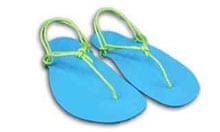
AF: For the (almost) purist, these sandals are based on the shoes worn by the Tarahumara people of Mexico who inspired Born to Run. They’re more comfortable than they look, but they didn’t really make me want to run fast. They feel more like something I’d wear to the beach.
KC: I struggle with any form of flip-flop as I find the toe post bit very uncomfortable even when strolling on a summer holiday, so a run in these was never going to be fun for me. Unless you have some of those Japanese flip-flop socks, they are also probably not ideal for our current weather conditions …
Vibram Fivefingers, £125
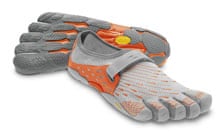
AF: Again, these have virtually no padding – which of course is the point – but for me they’re just too close to the ground. Also, I didn’t love the toes thing, although they don’t feel as strange as they perhaps look – while we were making our video, a passerby asked if we were filming Planet of the Apes.
KC: My main problem with these was getting them on! Putting each toe individually into the right bit was tricky. The sensation then takes some getting used to – I’d recommend anyone buying these to wear them around the house a bit first, to get used to it. They felt odder to walk in than to run, which was actually quite comfortable. I felt I’d need to really perfect the barefoot style before trying any kind of distance in them though. Definitely one for barefoot pros.
On Running Cloudsurfer and Cloudracer, £115
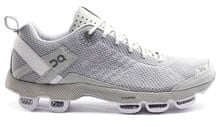
AF: These shoes are supposed to give you lots of cushioning when you land on the ground, but a barefoot takeoff. I’m not quite sure I experienced that, but the shoes did feel comfortable to run in. Because I tried the racing version, they were nice and light, but otherwise they felt more like conventional trainers than minimalist ones.
KC: Maybe it’s precisely because they are more of a hybrid between barefoot and conventional, but I really love these shoes. They seem to give me more bounce, are really lightweight (even the second-to-top model) and extremely comfortable. It’s hard to analyse your own running gait, of course, but people at my running club have commented that my running form is actually noticeably different and better in these – and I’ve run a series of PBs in them too. These are now my running shoes of choice.
Adidas Adapt, £65 and Motion, £85
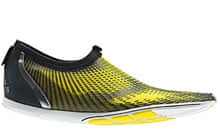
KC: I also tried the two Adidas barefoot-style running shoes. The Adapt felt very small to start with – they are a stretchy, almost neoprene-like material which feels rather like wearing a compression sock. They do stretch and adapt to your feet though. The tightness did make them feel like they’d rub on the back of your heel, but only on the first wear. They are incredibly lightweight and the soleis virtually non-existent, so another one for the seasoned barefoot runner.
The Motion have a bit more support and structure to them. Like the Adapt, the material on the foot feels very elastic, so again they are a snug fit – not so much around the side of the foot, as on top. Though they have laces they don’t feel they need them. The fit – like the Barefoot Evos – is quite wide in the toe area but that’s presumably part of the design as well.
Source: Read Full Article
